Fire on the Water Towers: Mapping Burn Scars on Mount Kenya Using Satellite Data to Reconstruct Recent Fire History
Abstract
1. Introduction
2. Materials and Methods
2.1. Study Area
2.2. A History of Forest Loss, Encroachment, and Fire
2.3. Data
2.3.1. Satellite Data
2.3.2. Elevation Data
2.3.3. Fire Reports
2.4. Procedures
2.4.1. Detected Fire Characteristics
2.4.2. Burn Scar Maps
2.4.3. MODIS Detected Fires vs. Landsat Burn Scars
3. Results and Discussion
3.1. Fire Locations and Timing
3.2. MODIS Active Fire Points in Mapped Burn Scars
3.3. MODIS Active Fire Points vs. dNBR: Correlations
3.4. MODIS Active Fire Points vs. dNBR: Regressions
3.5. dNBR and Fire Severity
MODIS Burned Areas vs. dNBR Burned Areas
3.6. Local Fire Reports
4. Conclusions
Author Contributions
Funding
Acknowledgments
Conflicts of Interest
References
- Sombroek, W.G.; Braun, H.M.H.; van der Pouw, B.J.A. Exploratory Soil Map and Agro-Climatic Zone Map of Kenya, 1980. Scale: 1:1,000,000. In Exploratory Soil Survey Report No. E1; Kenya Soil Survey Ministry of Agriculture—National Agricultural Laboratories: Nairobi, Kenya, 1982. [Google Scholar]
- Kenya National Bureau of Statistics. Home—Kenya National Bureau of Statistics, Nairobi, Kenya. Available online: https://www.knbs.or.ke/ (accessed on 12 August 2018).
- Kenya, Atlas of Our Changing Environment; United Nations Environment Programme: Nairobi, Kenya, 2009.
- Hemp, A. Climate change-driven forest fires marginalize the impact of ice cap wasting on Kilimanjaro. Glob. Chang. Biol. 2005, 11, 1013–1023. [Google Scholar] [CrossRef]
- Rucina, S.M.; Muiruri, V.M.; Kinyanjui, R.N.; McGuiness, K.; Marchant, R. Late Quaternary vegetation and fire dynamics on Mount Kenya. Palaeogeogr. Palaeoclimatol. Palaeoecol. 2009, 283, 1–14. [Google Scholar] [CrossRef]
- Kuhlbusch, T.; Crutzen, P. Black carbon, the global carbon cycle, and atmospheric carbon dioxide. In Biomass Burning and Global Change, Volume 1: Remote Sensing, Modeling, and Inventory Development, and Biomass Burning in Africa; The MIT Press: Cambridge, MA, USA, 1996; Volume 1, pp. 160–169. [Google Scholar]
- Fuller, D.O. Satellite remote sensing of biomass burning with optical and thermal sensors. Prog. Phys. Geogr. Earth Environ. 2000, 24, 543–561. [Google Scholar] [CrossRef]
- Chuvieco, E.; Congalton, R.G. Using Cluster Analysis to Improve the Selection of Training Statistics in Classifying Remotely Sensed Data. Photogramm. Eng. 1988, 54, 1275–1281. [Google Scholar]
- Pereira, J.M.C.; Chuvieco, E.; Beaudoin, A.; Desbois, N. Remote sensing methods for the study of large wildfires: A review. In Report of the Megafires Project; Universidad de Alcala: Alcala de Henares, Spain, 1997; pp. 127–183. [Google Scholar]
- Koutsias, N.; Karteris, M. Logistic regression modelling of multitemporal Thematic Mapper data for burned area mapping. Int. J. Remote Sens. 1998, 19, 3499–3514. [Google Scholar] [CrossRef]
- Rogan, J.; Yool, S.R. Mapping fire-induced vegetation depletion in the Peloncillo Mountains, Arizona and New Mexico. Int. J. Remote Sens. 2001, 22, 3101–3121. [Google Scholar] [CrossRef]
- Maingi, J.K. Mapping Fire Scars in a Mixed-Oak Forest in Eastern Kentucky, USA, Using Landsat ETM+ Data. Geocarto Int. 2005, 20, 51–63. [Google Scholar] [CrossRef]
- Gerard, F.; Plummer, S.; Wadsworth, R.; Sanfeliu, A.F.; Iliffe, L.; Balzter, H.; Wyatt, B. Forest fire scar detection in the boreal forest with multitemporal SPOT-VEGETATION data. IEEE Trans. Geosci. Remote Sens. 2003, 41, 2575–2585. [Google Scholar] [CrossRef]
- Koutsias, N.; Karteris, M. Burned area mapping using logistic regression modeling of a single post-fire Landsat-5 Thematic Mapper image. Int. J. Remote Sens. 2000, 21, 673–687. [Google Scholar] [CrossRef]
- Cocke, A.E.; Fulé, P.Z.; Crouse, J.E. Comparison of burn severity assessments using Differenced Normalized Burn Ratio and ground data. Int. J. Wildland Fire 2005, 14, 189–198. [Google Scholar] [CrossRef]
- Escuin, S.; Navarro, R.; Fernández, P. Fire severity assessment by using NBR (Normalized Burn Ratio) and NDVI (Normalized Difference Vegetation Index) derived from LANDSAT TM/ETM images. Int. J. Remote Sens. 2008, 29, 1053–1073. [Google Scholar] [CrossRef]
- van Wagtendonk, J.W.; Root, R.R.; Key, C.H. Comparison of AVIRIS and Landsat ETM+ detection capabilities for burn severity. Remote Sens. Environ. 2004, 92, 397–408. [Google Scholar] [CrossRef]
- Miller, J.D.; Thode, A.E. Quantifying burn severity in a heterogeneous landscape with a relative version of the delta Normalized Burn Ratio (dNBR). Remote Sens. Environ. 2007, 109, 66–80. [Google Scholar] [CrossRef]
- McCarty, J.L.; Loboda, T.; Trigg, S. A Hybrid Remote Sensing Approach to Quantifying Crop Residue Burning in the United States. Appl. Eng. Agric. 2008, 24, 515–527. [Google Scholar] [CrossRef]
- Moody, J.A.; Ebel, B.A.; Nyman, P.; Martin, D.A.; Stoof, C.; McKinley, R. Relations between soil hydraulic properties and burn severity. Int. J. Wildland Fire 2016, 25, 279–293. [Google Scholar] [CrossRef]
- Mallinis, G.; Koutsias, N. Comparing ten classification methods for burned area mapping in a Mediterranean environment using Landsat TM satellite data. Int. J. Remote Sens. 2012, 33, 4408–4433. [Google Scholar] [CrossRef]
- Bastarrika, A.; Chuvieco, E.; Martin, P. Mapping burned areas from Landsat TM/ETM+ data with a two-phase algorithm: Balancing omission and commission errors-ScienceDirect. Remote Sens. Environ. 2011, 115, 1003–1012. [Google Scholar] [CrossRef]
- Veraverbeke, S.; Lhermitte, S.; Verstraeten, W.W.; Goossens, R. Evaluation of pre/post-fire differenced spectral indices for assessing burn severity in a Mediterranean environment with Landsat Thematic Mapper. Int. J. Remote Sens. 2011, 32, 3521–3537. [Google Scholar] [CrossRef]
- Goetz, S.J.; Mack, M.C.; Gurney, K.R.; Randerson, J.T.; Houghton, R.A. Ecosystem responses to recent climate change and fire disturbance at northern high latitudes: Observations and model results contrasting northern Eurasia and North America. Environ. Res. Lett. 2007, 2, 045031. [Google Scholar] [CrossRef]
- Adams, H.D.; Luce, C.H.; Breshears, D.D.; Allen, C.D.; Weiler, M.; Hale, V.C.; Smith, A.M.; Huxman, T.E. Ecohydrological consequences of drought- and infestation-triggered tree die-off: Insights and hypotheses. Ecohydrology 2012, 5, 145–159. [Google Scholar] [CrossRef]
- McCool, S.F.; Burchfield, J.A.; Williams, D.R.; Carroll, M.S. An Event-Based Approach for Examining the Effects of Wildland Fire Decisions on Communities. Environ. Manag. 2006, 37, 437–450. [Google Scholar] [CrossRef] [PubMed]
- Key, C.H.; Benson, N.C. Landscape Assessment (LA). In Lutes, Duncan C.; Keane, Robert E.; Caratti, John F.; Key, Carl H.; Benson, Nathan C.; Sutherland, Steve; Gangi, Larry J. 2006. FIREMON: Fire Effects Monitoring and Inventory System. Gen. Tech. Rep. RMRS-GTR-164-CD. Fort Collins, CO: U.S. Department of Agriculture, Forest Service, Rocky Mountain Research Station. p. LA-1-55; U.S. Department of Agriculture: Washington, DC, USA, 2006; Volume 164. [Google Scholar]
- de Santis, A.; Chuvieco, E. GeoCBI: A modified version of the Composite Burn Index for the initial assessment of the short-term burn severity from remotely sensed data. Remote Sens. Environ. 2009, 113, 554–562. [Google Scholar] [CrossRef]
- Heward, H.; Smith, A.M.; Roy, D.P.; Tinkham, W.T.; Hoffman, C.M.; Morgan, P.; Lannom, K.O. Is burn severity related to fire intensity? Observations from landscape scale remote sensing. Int. J. Wildland Fire 2013, 22, 910–918. [Google Scholar] [CrossRef]
- Landmann, T. Characterizing sub-pixel Landsat ETM+ fire severity on experimental fires in the Kruger National Park, South Africa: Research letter. S. Afr. J. Sci. 2003, 99, 357–360. [Google Scholar]
- Hudak, A.T.; Brockett, B.H. Mapping fire scars in a southern African savannah using Landsat imagery. Int. J. Remote Sens. 2004, 25, 3231–3243. [Google Scholar] [CrossRef]
- Downing, T.A.; Imo, M.; Kimanzi, J. Fire occurrence on Mount Kenya and patterns of burning. GeoResJ 2017, 13, 17–26. [Google Scholar] [CrossRef]
- Schmitt, K. The Vegetation of the Aberdare National Park Kenya; Universitätsverlag Wagner: Innsbruck, Austria, 1991. [Google Scholar]
- Bussmann, R.W. The Forests of Mount Kenya (Kenya)-Vegetation, Ecology, Destruction and Management of A Tropical Mountain Forest Ecosystem; Universität Bayreuth: Bayreuth, Germany, 1994. [Google Scholar]
- Thompson, B.W. The Mean Annual Rainfall of Mount Kenya. Weather 1966, 21, 48–49. [Google Scholar] [CrossRef]
- Gathaara, G.N. Aerial Survey of the Destruction of Mt. Kenya, Imenti and Ngare Ndare Forest Reserves February-June 1999; FAO: Rome, Italy, 1999; p. 33. [Google Scholar]
- Notter, B.; MacMillan, L.; Viviroli, D.; Weingartner, R.; Liniger, H.-P. Impacts of environmental change on water resources in the Mt. Kenya region. J. Hydrol. 2007, 343, 266–278. [Google Scholar] [CrossRef]
- Niemelä, T.; Pellikka, P. Zonation and Characteristics of the Vegetation of Mt; University of Helsinki: Helsinki, Finland, 2004; p. 7. [Google Scholar]
- UNESCO World Heritage. Mount Kenya National Park/Natural Forest. UNESCO World Heritage Centre. Available online: https://whc.unesco.org/en/list/800/ (accessed on 12 August 2018).
- Wesche, K.; Miehe, G.; Kaeppeli, M. The Significance of Fire for Afroalpine Ericaceous Vegetation. Mt. Res. Dev. 2000, 20, 340–347. [Google Scholar] [CrossRef]
- Kenya Wildlife Service. Mount Kenya Forest Fire Overview; Kenya Wildlife Service: Nairobi, Kenya, 2012.
- Njagi, J. Raging fires destroy forests on Mt Kenya and Aberdares. Daily Nation, 17 March 2012. [Google Scholar]
- Davies, D.K.; Ilavajhala, S.; Wong, M.M.; Justice, C.O. Fire Information for Resource Management System: Archiving and Distributing MODIS Active Fire Data. IEEE Trans. Geosci. Remote Sens. 2009, 47, 72–79. [Google Scholar] [CrossRef]
- Justice, C.O.; Giglio, L.; Roy, D.; Boschetti, L.; Csiszar, I.; Davies, D.; Korontzi, S.; Schroeder, W.; O’Neal, K.; Morisette, J. MODIS-derived global fire products. In Land Remote Sensing and Global Environmental Change; Springer: New York, NY, USA, 2010; pp. 661–679. [Google Scholar]
- Giglio, L.; Descloitres, J.; Justice, C.O.; Kaufman, Y.J. An Enhanced Contextual Fire Detection Algorithm for MODIS. Remote Sens. Environ. 2003, 87, 273–282. [Google Scholar] [CrossRef]
- United States Geological Survey (USGS). The Normalized Burn Ratio (NBR)-Brief Outline of Processing Steps; USGS: Reston, VA, USA, 2004; p. 1.
- Camberlin, P.; Boyard-Micheau, J.; Philippon, N.; Baron, C.; Leclerc, C.; Mwongera, C. Climatic gradients along the windward slopes of Mount Kenya and their implication for crop risks. Part 1: Climate variability. Int. J. Climatol. 2014, 34, 2136–2152. [Google Scholar] [CrossRef]
- Schroeder, W.; Oliva, P.; Giglio, L.; Quayle, B.; Lorenz, E.; Morelli, F. Active fire detection using Landsat-8/OLI data. Remote Sens. Environ. 2016, 185, 210–220. [Google Scholar] [CrossRef]
- Csiszar, I.; Loboda, T.; French, N.H.F.; Giglio, L.; Hockenberry, T.L. A Multi-Sensor Approach to Fine-Scale Fire Characterization; University of Maryland: College Park, MD, USA, 2014; p. 4. [Google Scholar]
- USDA Forest Service. Watershed-WFW-Watershed, Fish, Wildlife, Air & Rare Plants-USDA Forest Service. Available online: https://www.fs.fed.us/biology/watershed/burnareas/background.html (accessed on 12 August 2018).
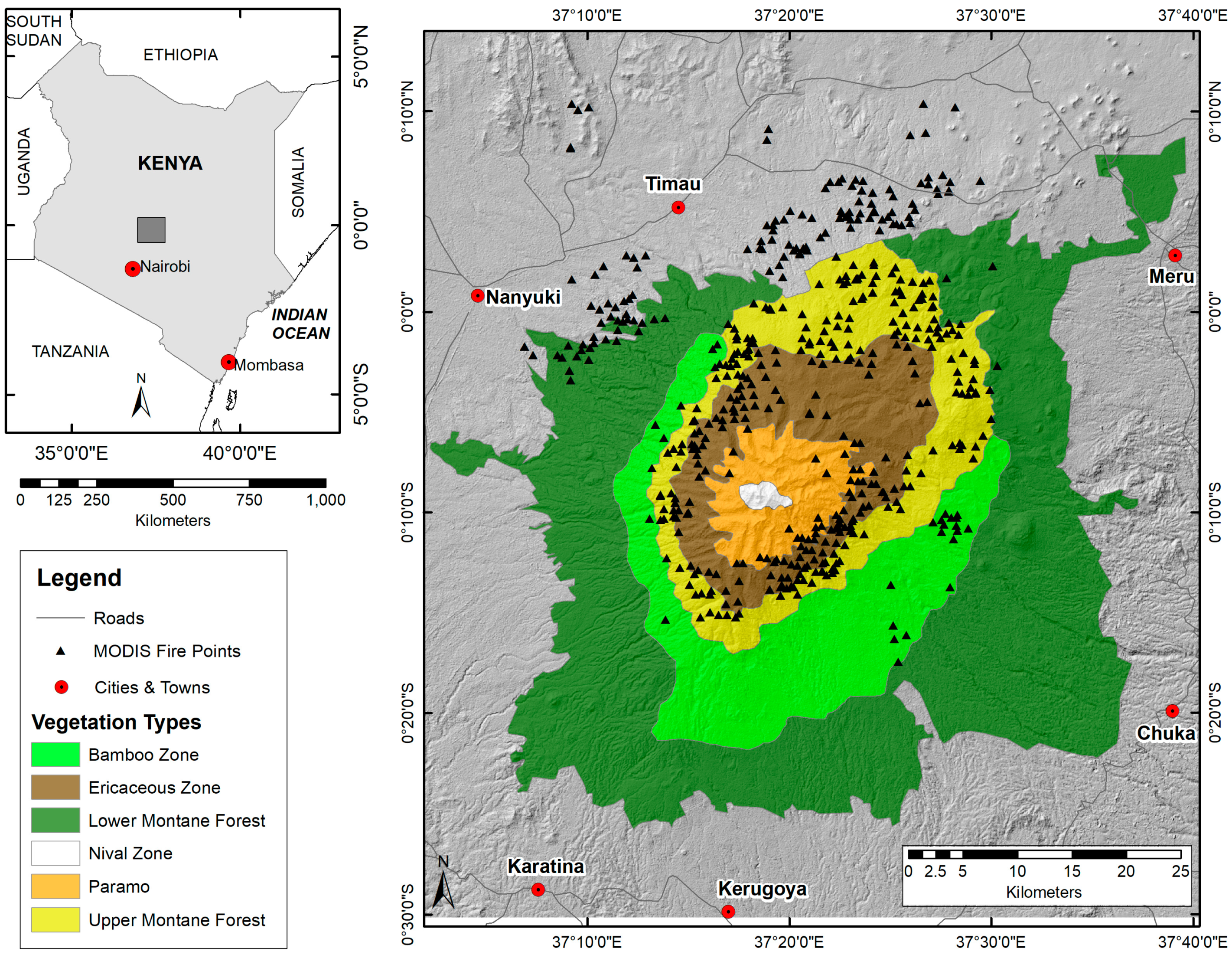
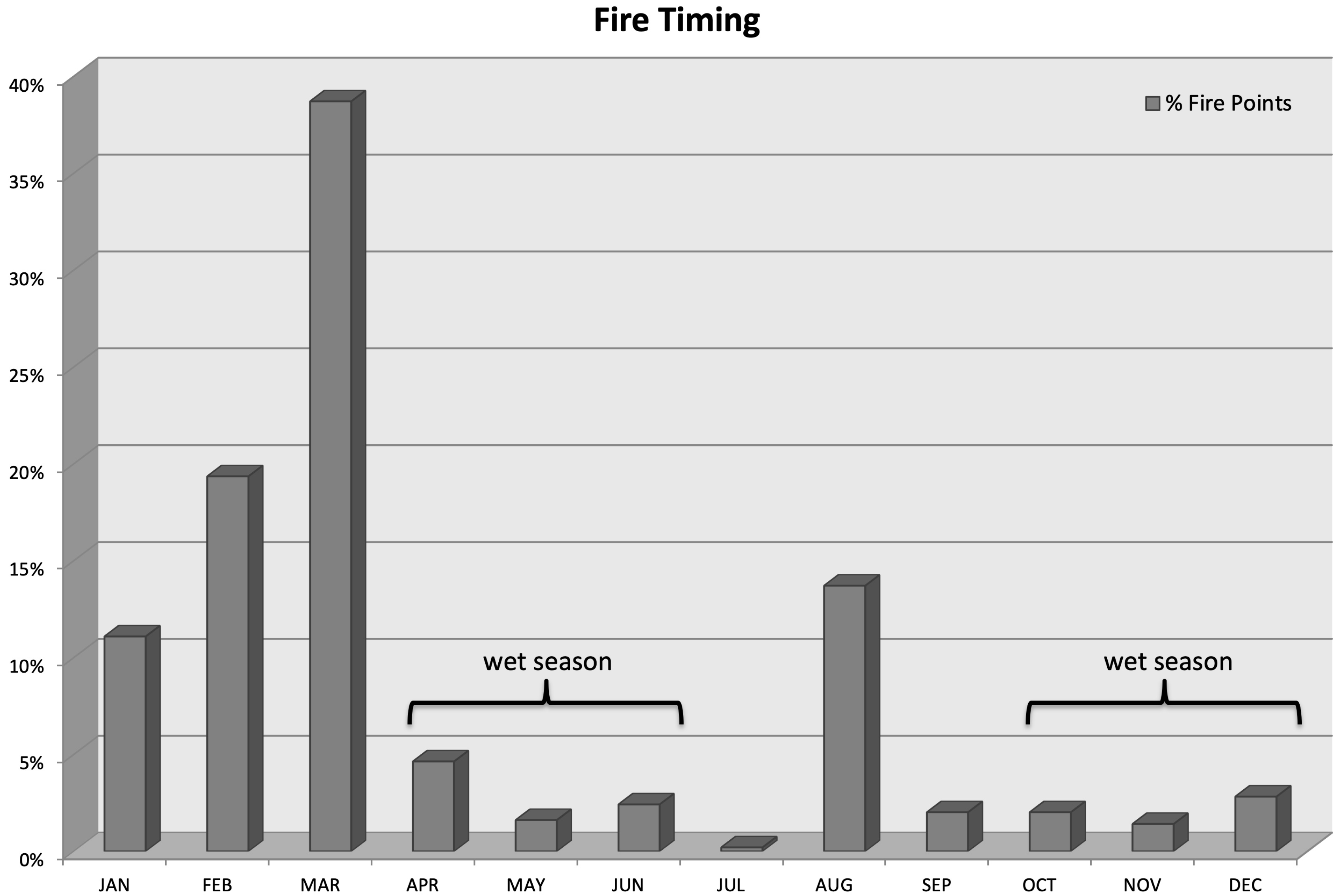
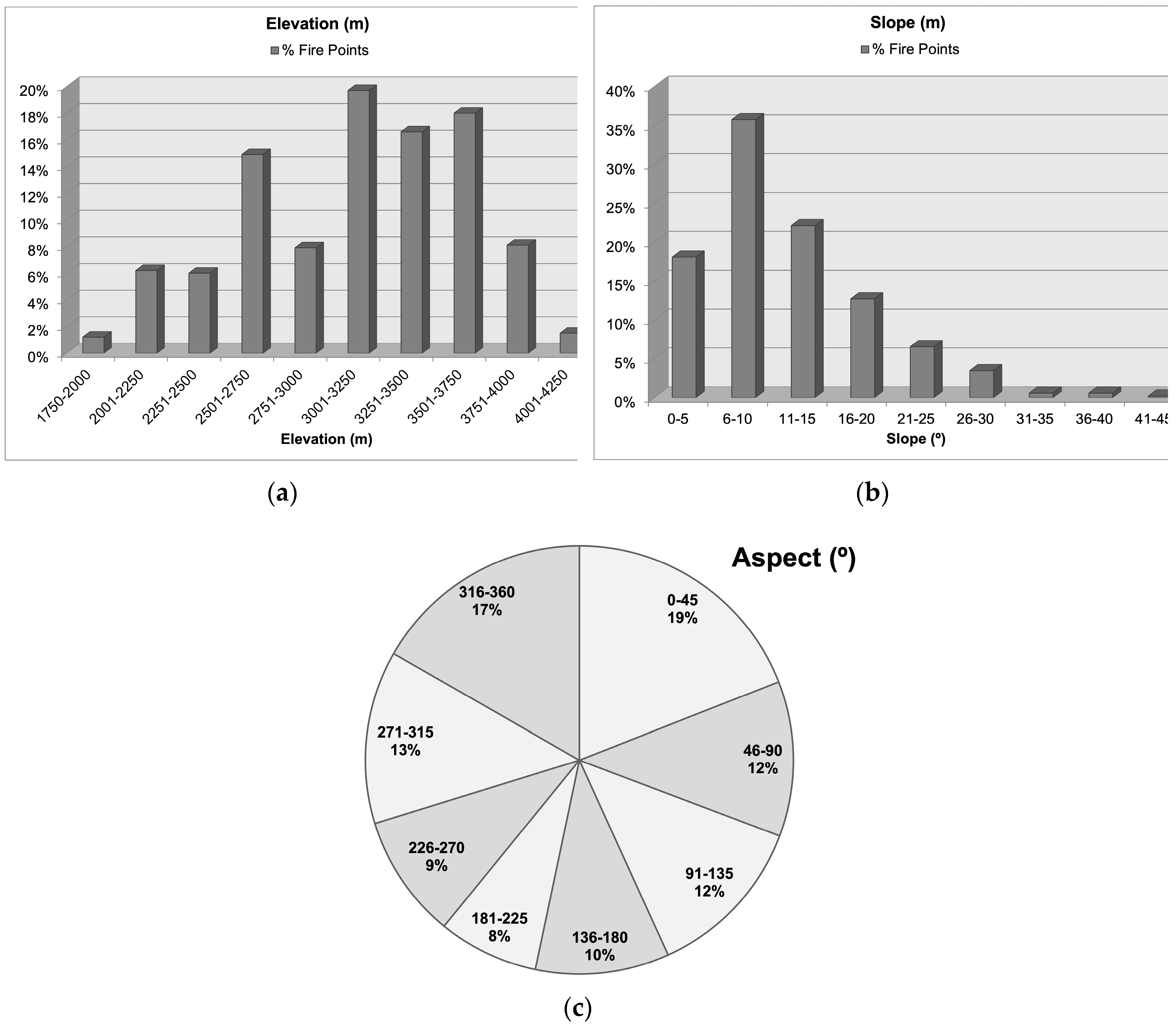
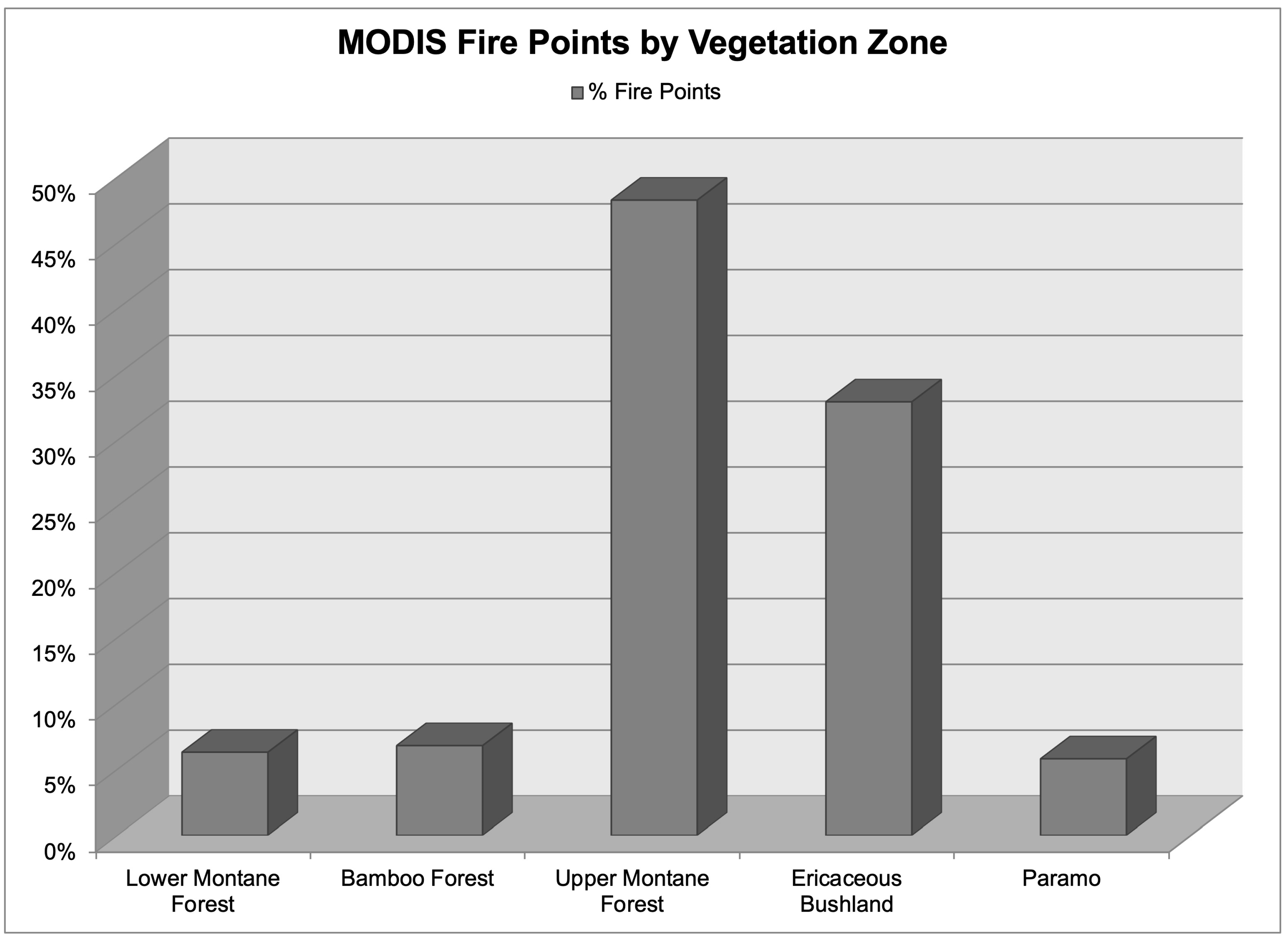
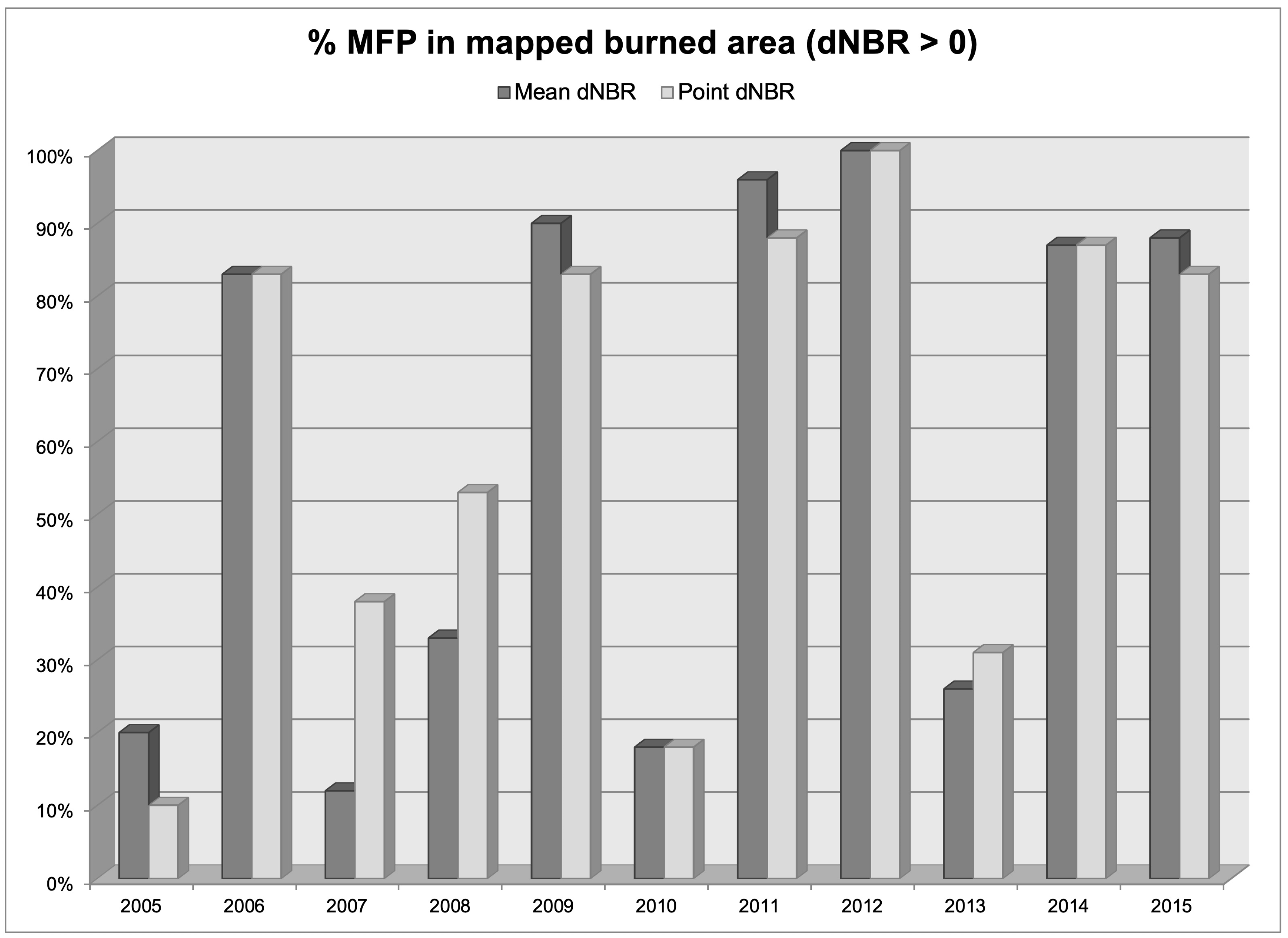
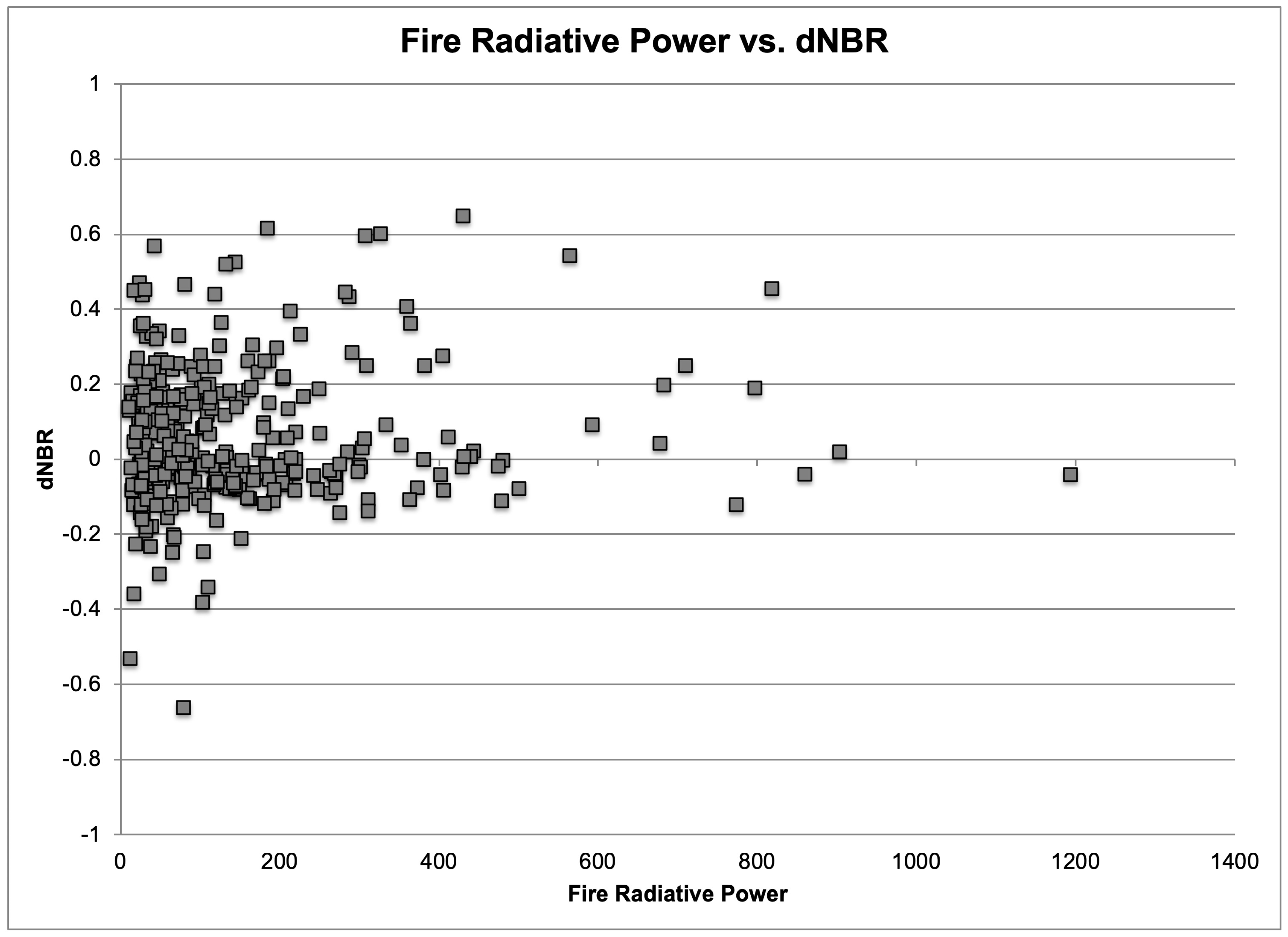
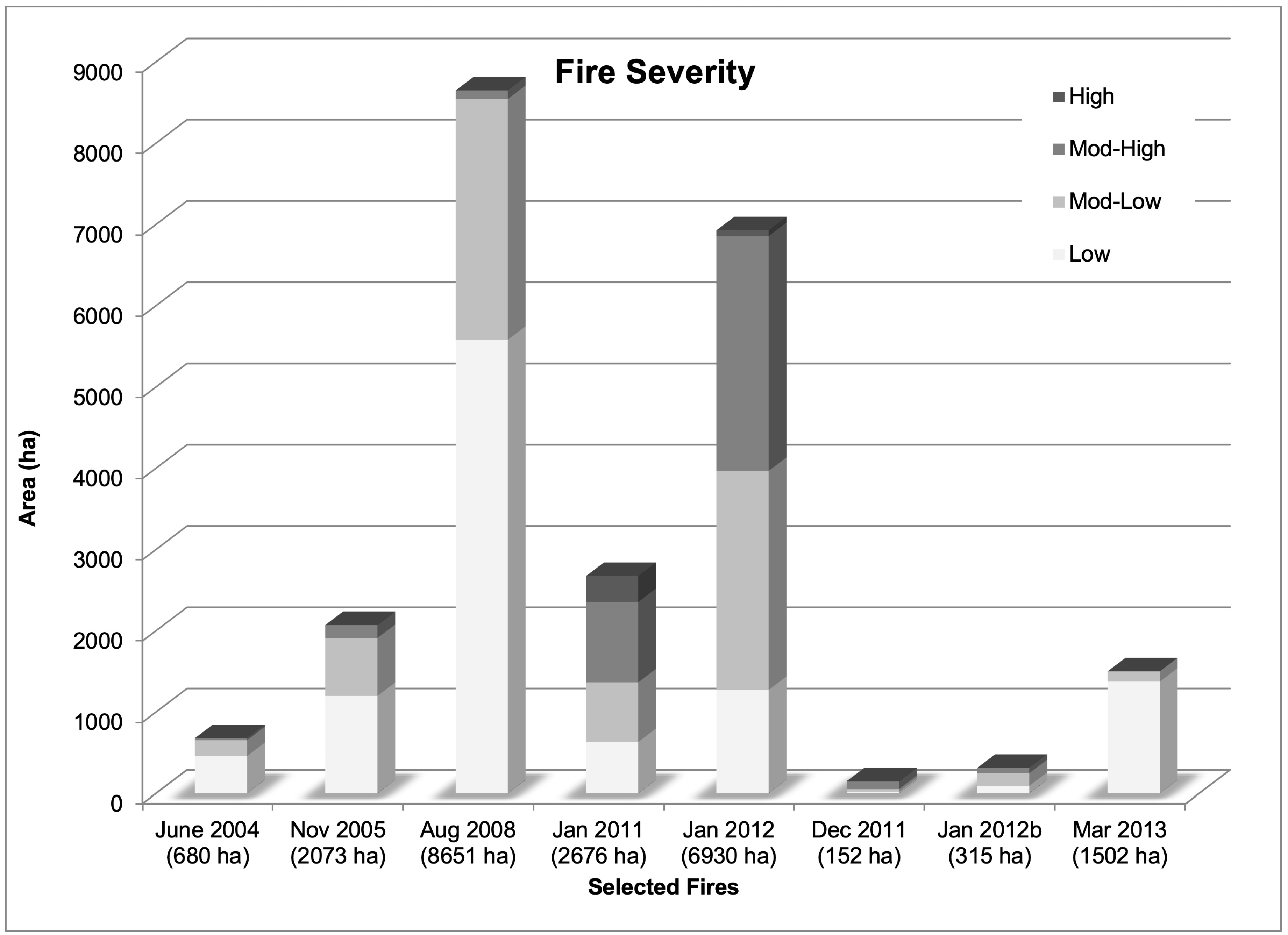
| Image Date | Instrument | Days between Images |
|---|---|---|
| 3-Mar-04 | ETM+ | -- |
| 1-Jan-05 | ETM+ | 305 |
| 5-Feb-06 | ETM+ | 400 |
| 8-Feb-07 | ETM+ | 367 |
| 26-Jan-08 | ETM+ | 352 |
| 13-Feb-09 | ETM+ | 384 |
| 21-Apr-10 | ETM+ | 432 |
| 7-Mar-11 | ETM+ | 320 |
| 21-Jan-12 | ETM+ | 320 |
| 24-Feb-13 | ETM+ | 400 |
| 3-Feb-14 | OLI | 344 |
| 22-Feb-15 | OLI | 384 |
| dNBR | Burn Severity |
|---|---|
| <−0.25 | High post-fire regrowth |
| −0.25 to −0.1 | Low post-fire regrowth |
| −0.1 to +0.1 | Unburned |
| 0.1 to 0.27 | Low-severity burn |
| 0.27 to 0.44 | Moderate-low severity burn |
| 0.44 to 0.66 | Moderate-high severity burn |
| >0.66 | High-severity burn |
| Vegetation Zone | Elevation Range (m) |
|---|---|
| Nival | 4144–5065 |
| Paramo | 3354–4760 |
| Ericaceous Bushland | 2990–4245 |
| Upper Montane Forest | 2651–3876 |
| Bamboo Forest | 2120–3283 |
| Lower Montane Forest | 1442–3116 |
| All MODIS Fire Pts | |||||
| Pearson’s r | |||||
| Date | Single Pixel dNBR | p | 500 m Mean dNBR | p | n |
| 2006–2007 | 0.3882 | 0.0053 | 0.3794 | 0.0066 | 50 |
| 2013–2014 | 0.5646 | 0.0283 | -- | -- | 15 |
| 2014–2015 | -- | -- | -0.4689 | 0.0208 | 24 |
| All MODIS Fire Pts | |||||
| Spearman’s rho | |||||
| Date | Single Pixel dNBR | p | 500 m Mean dNBR | p | n |
| 2006–2007 | 0.3482 | 0.0148 | 0.3457 | 0.0155 | 50 |
| 2007–2008 | -- | -- | −0.5108 | 0.0352 | 18 |
| 2008–2009 | 0.3288 | 0.0096 | 0.2591 | 0.0414 | 63 |
| 2013–2014 | 0.6821 | 0.0107 | 0.6357 | 0.0174 | 15 |
| 2014–2015 | -- | -- | −0.5504 | 0.0083 | 24 |
| Selected Fires | Single Pixel dNBR | p | 500 m Mean dNBR | p | n |
| All Points | 0.2195 | 0.0282 | 0.3124 | 0.0016 | 100 |
| 2013–2014 | 0.6311 | 0.0207 | -- | -- | 13 |
| Spearman’s rho | |||||
| Selected Fires | Single Pixel dNBR | p | 500 m Mean dNBR | p | n |
| All Points | 0.2804 | 0.0053 | 0.3089 | 0.0021 | 100 |
| 2013–2014 | -- | -- | -- | -- | -- |
| All MODIS Fire Pts | |||||
| 500 m Mean dNBR | |||||
| Date | Intercept | Slope | FRP | p | R2 |
| 2006–2007 | −0.080051 | 0.0002520 | X | 0.0066 | 0.144 |
| 2007–2008 | 0.250982 | −0.0613224 | ln(X) | 0.0406 | 0.237 |
| 2008–2009 | 0.179452 | −2.2728200 | 1/X | 0.0190 | 0.869 |
| 2013–2014 | 0.242368 | −6.2008000 | 1/X | 0.0016 | 0.550 |
| 2014–2015 | 0.220174 | −0.0337444 | ln(X) | 0.0075 | 0.283 |
| All MODIS Fire Pts | |||||
| Single Pixel dNBR | |||||
| Date | Intercept | Slope | FRP | p | R2 |
| 2006–2007 | −0.112765 | 0.0007947 | X | 0.0053 | 0.151 |
| 2008–2009 | −0.142567 | 0.0637314 | ln(X) | 0.0401 | 0.672 |
| 2013–2014 | 0.261226 | −7.3644400 | ln(X) | 0.0004 | 0.632 |
| Data | Intercept | Slope | FRP | p | R2 | |
|---|---|---|---|---|---|---|
| All | 500 m Mean dNBR | 0.122,947 | 0.009,114,5 | sqrt(X) | 0.0011 | 0.104 |
| All | Single Pixel dNBR | 0.125,52 | 0.010,018,1 | sqrt(X) | 0.0205 | 0.536 |
| 2014 | 500 m Mean dNBR | 0.031,173 | 0.026,599,8 | ln(X) | 0.0433 | 0.321 |
| 2014 | Single Pixel dNBR | 0.008,101 | 0.000,166,4 | sqrt(Y) | 0.0155 | 0.426 |
| Fire (MCD14ML) | Vegetation Zone | Area (ha) (MCD64) | Area (ha) (dNBR) | Landsat Post-Fire Date | Days since Fire |
|---|---|---|---|---|---|
| East Side 6/2/2004* | UM/ EB | X | 720 | 1/1/2005 | 213 |
| N-NW Side 3/9/2005 | UM | 525 | 280 | 2/5/2006 | 334 |
| SW Side 11/17/2005–11/18/2005* | UM/ EB | 200 | 2073 | 2/5/2006 | 81 |
| East Side 2/8/2006–2/16/2006 | UM/ EB/ PA | 10275 | X | 2/8/2007 | 357 |
| Bamboo 2/21/2006–2/23/2006 | BA | X | X | 2/8/2007 | 350 |
| NE Side 3/6/2007–3/7/2007 | UM/EB | 10275 | X | 1/26/2008 | 325 |
| North Side 5/20/2007–5/22/2007 | UM | X | X | 1/26/2008 | 249 |
| NW Side 2/24/2008–2/27/2008 | UM | 525 | na | 2/13/2009 | 352 |
| NW Side High Elev 3/5/2008 | UM | 225 | na | 2/13/2009 | 345 |
| 8/27/2008–8/30/2008* | UM/EB | 6250 | 8651 | 2/13/2009 | 167 |
| Bamboo 3/3/2009, 3/26/2009 | BA | X | X | 4/21/2010 | 391 |
| North Side 3/24/2009–3/28/2009 | EB/UM | 5425 | X | 4/21/2010 | 389 |
| Near East Side 12/31/2010 | UM | X | na | 3/7/2011 | 66 |
| East Side 1/28/2011–1/29/2011* | UM/EB | 2275 | 2676 | 3/7/2011 | 37 |
| North Side 3/11/2011 | UM | 1050 | X | 1/21/2012 | 316 |
| NW Side 4/12/2011–4/13/2011 | UM | 850 | na | 1/21/2012 | 283 |
| NE Side 12/15/2011* | UM | 150 | 160 | 1/21/2012 | 37 |
| NE Side 1/14/2012* | UM | 225 | 440 | 1/21/2012 | 7 |
| South Side 1/17/2012–1/19/2012* | UM/EB | 5967 | 6930 | 1/21/2012 | 2 |
| North Side 2/8/2012–2/10/2012 | UM | 1650 | X | 2/24/2013 | 380 |
| High Elev 3/13/2012 | PA | 1975 | na | 2/24/2013 | 348 |
| SE Side 3/18/2012–3/21/2012 | EB/UM | 150 | X | 2/24/2013 | 340 |
| North Side 3/1/2013–3/5/2013* | UM/EB | 1275 | na | 2/3/2014 | 335 |
| North Side 8/16/2014–8/17/2014 | UM | 1475 | na | 2/22/2015 | 189 |
| North Side 9/27/2014 | UM | 125 | na | 2/22/2015 | 148 |
© 2019 by the authors. Licensee MDPI, Basel, Switzerland. This article is an open access article distributed under the terms and conditions of the Creative Commons Attribution (CC BY) license (http://creativecommons.org/licenses/by/4.0/).
Share and Cite
Henry, M.C.; Maingi, J.K.; McCarty, J. Fire on the Water Towers: Mapping Burn Scars on Mount Kenya Using Satellite Data to Reconstruct Recent Fire History. Remote Sens. 2019, 11, 104. https://doi.org/10.3390/rs11020104
Henry MC, Maingi JK, McCarty J. Fire on the Water Towers: Mapping Burn Scars on Mount Kenya Using Satellite Data to Reconstruct Recent Fire History. Remote Sensing. 2019; 11(2):104. https://doi.org/10.3390/rs11020104
Chicago/Turabian StyleHenry, Mary C., John K. Maingi, and Jessica McCarty. 2019. "Fire on the Water Towers: Mapping Burn Scars on Mount Kenya Using Satellite Data to Reconstruct Recent Fire History" Remote Sensing 11, no. 2: 104. https://doi.org/10.3390/rs11020104
APA StyleHenry, M. C., Maingi, J. K., & McCarty, J. (2019). Fire on the Water Towers: Mapping Burn Scars on Mount Kenya Using Satellite Data to Reconstruct Recent Fire History. Remote Sensing, 11(2), 104. https://doi.org/10.3390/rs11020104





